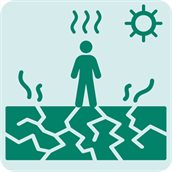Heat stress
The term heat stress refers (PDF) to a range of health problems caused by exposure to high temperatures, particularly during heat waves. Symptoms can vary from mild discomforts such as fatigue, difficulty concentrating, headaches, dizziness, muscle pain, thirst, and sleep disturbances, to more serious conditions like heat cramps, fainting, and heatstroke. In extreme cases, heat stress can be fatal. Certain groups are more vulnerable to heat-related health issues. The elderly are most at risk, but other vulnerable groups include children, young people, those taking medication, people unable to care for themselves, indoor and outdoor workers, athletes, event attendees, and the homeless.
According to the United Nations Intergovernmental Panel on Climate Change (IPCC), heat stress encompasses a range of conditions in both terrestrial and aquatic organisms when the body absorbs excessive heat due to high air or water temperatures or thermal radiation. In aquatic animals, factors like hypoxia and acidification can increase sensitivity to heat. For mammals (including humans) and birds, heat stress is worsened by a combination of high temperatures, high humidity, and low wind speeds, which can impair the body’s ability to regulate temperature.
Daytime heat often causes immediate strain on the body, especially during peak sun hours when outdoor activity or work is unavoidable. Night-time heat, however, poses a different challenge: if temperatures remain high after sunset, the body cannot fully recover from the day’s stress. This lack of relief can have negative effects on health, disrupt sleep, and increase the risk of cumulative fatigue. Prolonged exposure to both day- and night-time heat can reduce productivity, impair decision-making, and heighten the risk of workplace accidents, particularly in physically demanding jobs. In agriculture, construction, and other outdoor sectors, heat can also cause dehydration and slower reaction times, leading to mishandling of tools or machinery. For vulnerable individuals and those working in high-risk environments, preventive measures such as shaded rest areas, hydration schedules, adjusted work hours, and early warning systems are crucial.
The mind map Risks of Extreme Heat shows that hot weather can also have other impacts on society than heat stress and health issues. These impacts can be clustered in risk for infrastructure, water systems, liveability, and public spaces.
Urban heat
Built-up areas are often significantly warmer than their rural surroundings, a phenomenon known as the Urban Heat Island (UHI) effect. This effect arises due to the high density of buildings, limited green spaces, and tall structures that obstruct natural airflow. As a result, cities and other built-up areas can be several degrees warmer than the countryside, particularly at night and early morning. In the Netherlands, the average nighttime UHI effect in cities ranges from 2 to 3 °C, but during nights without wind and with cloudless skies, this difference can exceed 6 °C. Often, projections of temperatures are made for non-urban areas, so without the urban heat island effect.
During heat waves, certain urban locations can become uncomfortably hot, posing health risks, especially for vulnerable populations. It is important to distinguish between air temperature and perceived temperature. While air temperature reflects the actual warmth of the air, perceived temperature accounts for factors such as radiation, humidity and wind, indicating how hot it actually feels to a person.
For instance, when the air temperature is 30 °C, the perceived temperature in the sun can soar to 40 °C or more. Within cities, the perceived outdoor temperature can vary dramatically. Differences of up to 22 °C have been observed between shaded parks and sun-exposed streets.
When materials are exposed to direct sunlight, their surface temperature can rise quickly. They can become so hot that touching them is uncomfortable or even dangerous. In fact, they may radiate enough heat that you can feel it without making contact. This can be particularly problematic for children and animals, who may burn themselves on hot playground equipment or pavement.

